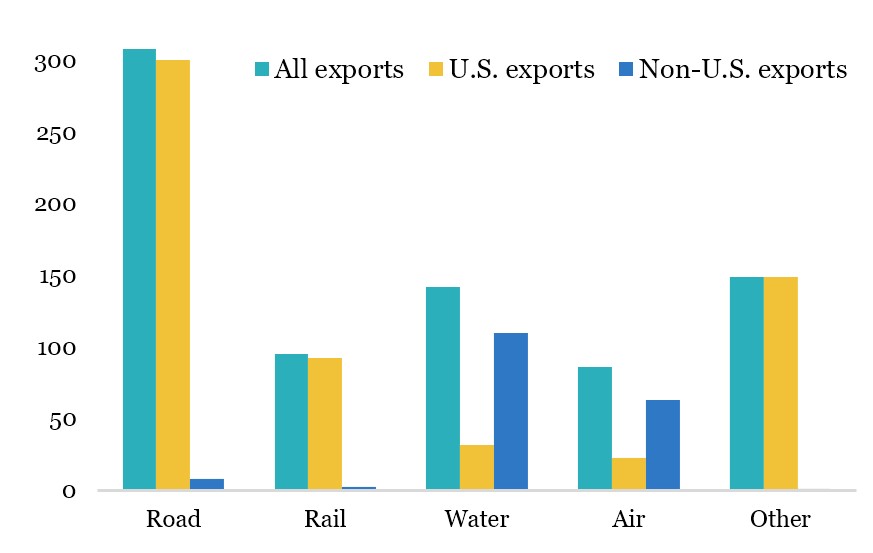Five years of frequent supply chain challenges have been an important reminder of the vulnerabilities of our global trade infrastructure to the impacts of geopolitics, trade wars, disease, climate change and human error. Now, rising economic nationalism and increases in global trade frictions are forcing countries to further reassess their resilience to external shocks.
The export dependence of the Canadian economy makes this resilience all the more critical to our economic well-being, prompting the Government of Canada to set an ambitious objective of doubling non-U.S. exports over the next decade. But given Canada’s expansive geography, scattered resource base and widely disbursed industrial landscape, achieving this goal will require a generational shift in our trade-enabling infrastructure. As such, the federal government recently announced a fund for projects of national importance, with the expressed aim of expanding trade beyond continental routes.
You should also check out
With timely insights and financial analysis from our experts, Export Development Canada can help you enter new markets, grow your global business, and reduce risks with confidence.
Canada’s reliance on roads and ground transport for exports
Historical trade patterns, a vestige of geographic proximity and industrial integration, resulted in Canadian exports relying primarily on ground transportation, mainly for the movement of goods into and out of the United States. In 2024, more than 70% of Canada’s goods exports travelled by road, rail or pipeline—a pattern that hasn’t changed much in decades. This reliance on north-south networks led to comparatively lower levels of investment in other modes of transport, including trans-Canadian commercial rail, airports and port facilities.
Share of Canadian exports by mode, C$ billions, 2024

What diversification means
As Canada diversifies its trade, airports and ports will face more traffic and capacity pressures. This requires expanded marine and air infrastructure, as well as significant investment in east-west transportation networks, especially if interprovincial trade grows.
Most assessments of Canadian trade-enabling infrastructure suggest that previously planned capital investment doesn’t meet existing demand, let alone support future growth. Canada’s infrastructure deficit is estimated at $110 billion to $270 billion. Compounding these shortfalls are structural and regulatory hurdles that complicate private sector involvement, while crucial infrastructure systems experience the normal erosions of time.
Supply chain bottlenecks make things worse, with congestion and poor maintenance slowing goods movement across all modes. Together, these factors hinder competitiveness, highlighting the urgent need for strategic investment. Synchronizing intermodal operations while building ancillary support industries, such as transloading and warehousing, are all part of an interconnected trade supply chain.
Canadian ports lag in global rankings and infrastructure investment
Canadian ports underperform compared to other Organisation for Economic Co-operation and Development (OECD) nations and trail countries like China, the U.S., Singapore and South Korea. Extended wait times contribute to operational inefficiencies and disruptions within supply chains. A 2023 World Bank ranking of container port performance placed two of Canada’s three largest ports in the bottom 15% globally. According to the Canadian Association of Port Authorities, marine infrastructure needs $15 billion to $21.5 billion in investment over the next 15 years, mostly for expansion.
Rail and air freight infrastructure: Bottlenecks and investment gaps
Canadian rail networks face considerable capacity limits and weak links to ports and airports. Limited expansion and underdeveloped rail lines in rural areas continue to constrain overall capacity. Congestion at port container terminals is intensified by rail-related concerns. Inland warehousing and transloading shortages clog rail corridors. Transport Canada estimates $284 billion in rail investment is needed by 2070, with a $2.8 billion annual shortfall.
Airfreight moves fewer goods but accounts for high-value shipments. In 2023, airfreight made up 30% of the value of Canada’s non-U.S. cargo. Air remains the primary method for fast delivery to distant markets beyond the U.S. and time-sensitive goods like live fish. Expanding air capacity means more routes and better facilities, including cold storage. Improving air links to commodity sourcing regions, especially those in remote and northern Canadian communities, should be a priority.
The bottom line: Why investing in trade infrastructure boosts Canada’s export resilience
Investment in trade-enabling infrastructure is essential for a strong, competitive economy. For Canada, that means connecting industries and enabling exports. New ports, railways and airports are only part of the solution. Improving efficiency and building logistics support, like warehousing, will unlock capacity and boost competitiveness. Strategic investment today will help Canadian exporters access new markets, reduce supply chain risks and strengthen resilience against global disruptions.
This week, a very special thanks to Prerna Sharma, senior economist in our EDC economics department.
As always, at EDC Economics, we value your feedback. If you have ideas for topics that you’d like us to explore, please email us at economics@edc.ca and we’ll do our best to cover them.
This commentary is presented for informational purposes only. It’s not intended to be a comprehensive or detailed statement on any subject and no representations or warranties, express or implied, are made as to its accuracy, timeliness or completeness. Nothing in this commentary is intended to provide financial, legal, accounting or tax advice nor should it be relied upon. EDC nor the author is liable whatsoever for any loss or damage caused by, or resulting from, any use of or any inaccuracies, errors or omissions in the information provided.






